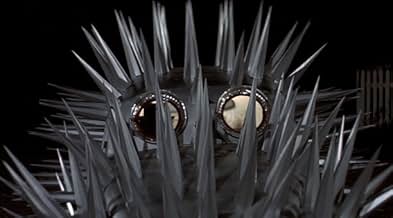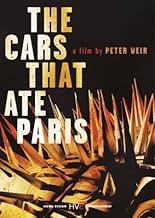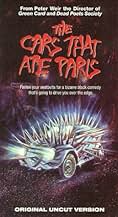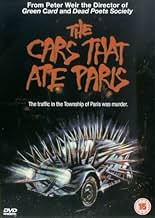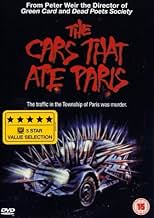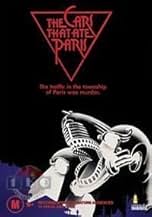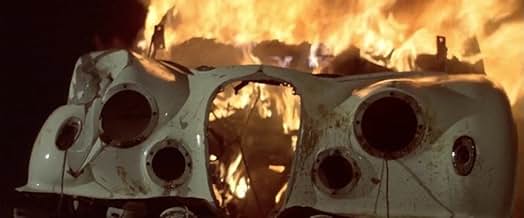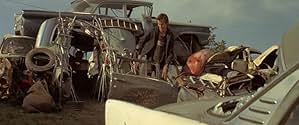Aggiungi una trama nella tua linguaThe small town of Paris, Australia deliberately causes car accidents, then sells/salvages all valuables from the wrecks as a means of economy.The small town of Paris, Australia deliberately causes car accidents, then sells/salvages all valuables from the wrecks as a means of economy.The small town of Paris, Australia deliberately causes car accidents, then sells/salvages all valuables from the wrecks as a means of economy.
- Regia
- Sceneggiatura
- Star
- Premi
- 1 vittoria e 1 candidatura in totale
- Man in House
- (as Herbie Nelson)
- Clive Smedley
- (non citato nei titoli originali)
Recensioni in evidenza
At one point the score turns Morricone circa Once Upon a Time in the West and we get a showdown in the street and young men dressed with cowboy hats. We get Carmageddon-style cars circling the statue of a cannon like Comanches painted for war. We get the vague promise of a subplot about car crash survivors turned vegetables who are kept in the hospital of the small town and who later turn up in a ball masque dressed in hoods and carton boxes (a nod to Shock Corridor?), but it never goes anywhere. Peter Weir went on to make such remarkable films as Picnic at Hanging Rock and The Last Wave, and while this never reaches the hypnotic levels of those films, it's intriguing in its own quirky awkward way. It's like a movie struggling with itself, a cult classic trying to break free from the confines of a forgettable eccentricity.
Don't watch it if you think low budget is the same as being 'amateurish' because it's not. And if you're not used to Australian English, well, try not to panic. Doesn't matter if you don't get every word - just go with it!
This is the kind of film you don't see much any more, perhaps a product of its era. They weren't thinking much about marketing or target demographics - these filmmakers were just having a lot of fun, experimenting and coming up with something unique. Genre crossing, challenging and freaky, it also taps into some big themes about Australian identity and paranoia.
I should identify that this is not a movie for those with short attention spans. It's not likely to stick heavily in your memory the way that most of Peter Weir's movies do (it's certainly not my favorite of his movies). But still, it's something to check out as a historical reference if nothing else.
"I can drive!" You'll probably feel like you can too.
Peter Weir deliciously blends several elements into the plot line. On one hand, we have the incredibly surreal idea of a whole town killing people for their valuables. This blends with the whole crazy cult idea, and this in turn mixes with the idea of the things that people will do to survive. Weir has speckled the movie with loads of great imagery, such as the old women who's job it is to take the valuables from the cars stuffing clothes down their top, and the devilish cornerstone of society, the Mayor, overseeing all the horror. Despite all the film's good elements, however, Weir has failed to make the film a complete whole. It may be down to inexperience, but while he's busy creating his atmosphere; the characters have been forgotten about, and this makes it difficult to care for them, and the story beyond an aesthetic level. There is much to like about this movie, and it's definitely worth seeing for the imagery alone; but it's hard to really love it, and that stops me from giving the film a high rating. I still recommend the movie, however, as it's well worth seeing.
Lo sapevi?
- QuizThe opening scenes that feature a couple driving in a car and smoking prominently displaying cigarettes were a parody of a commercial aired on Australian television at the time of the film's original release. Website 'Peterweircave' says of this: "The opening "advertisement", which many viewers seem to take as blatant product placement for Coke and Alpine cigarettes, was actually a spoof in itself. At the time it was made, movies in Australia were often preceded by ads for cigarettes and such. By putting this before the opening credits, Weir was fooling the viewers into thinking this was yet another ad."
- BlooperThe people thrown from the car in the first accident are obvious dummies.
- Citazioni
The Mayor: Have you country boys forgotten the old school war cry? Have you forgotten the meaning of those words? Womerah, Womerah, babaluke, boomerang, crocodile, kookaburra, wombat, orang-outang. Wheeho, whayho, terramungamine, quondong, billabong, gundabluey pine. Platypus, emu, wallaby, 'roo, ibis, brolga, and white cockatoo. Murrumburrah, Cowra, Coolamon, Banco, Boggabri, Narromine, Nevertire, Yanco! Whoo-ra! Whoo-ra! Ha! Ha! Ha! Yanco High School, Yah! Yah! Yah!
- Versioni alternativeUS version, titled _The Cars that Ate People (1974)_ was shortened to 74 minutes by the distributor, and star Terry Camilleri's voice is dubbed. The film was finally reissued in the USA at complete length in 1984.
- ConnessioniEdited into Terror Nullius (2018)
- Colonne sonoreRock of Ages
(uncredited)
Lyrics by Augustus Montague Toplady
Music by Thomas Hastings
Played at the church
I più visti
- How long is The Cars That Ate Paris?Powered by Alexa
Dettagli
- Data di uscita
- Paese di origine
- Lingua
- Celebre anche come
- The Cars That Ate Paris
- Luoghi delle riprese
- Aziende produttrici
- Vedi altri crediti dell’azienda su IMDbPro
Botteghino
- Budget
- 250.000 A$ (previsto)
- Lordo in tutto il mondo
- 786 USD
- Tempo di esecuzione
- 1h 28min(88 min)
- Mix di suoni
- Proporzioni
- 2.39 : 1

![Guarda Trailer [OV]](https://m.media-amazon.com/images/M/MV5BYmRjNDU0MDItYTEwZS00NmM5LTkyNTEtMTg2MGU1ZGRiODQ4XkEyXkFqcGdeQXRyYW5zY29kZS13b3JrZmxvdw@@._V1_QL75_UX500_CR0)
